The Beauty of Breathwork
The breath is our primary source of energy and the true essence of life.
When we cultivate the breath we can master the mind. Regulating the breath enhances your physical, emotional, and spiritual well-being—the key to a vital life. From powerful pranayama (breathing expansion) to the wonderful Wim Hof’s guided breathwork, we can activate our greatest potential with a tool that we are naturally born with. Discover the powerful healing benefits of breathwork and different breathing techniques to cultivate Zen and inner peace.
Types of Breathwork
In the Seven Spiritual Laws of Yoga, Deepak Chopra states that we take over 17,000 breaths each day with over 500 million breaths in a lifetime. Our breathing supports every experience we have from the moment we take our first inhalation as we arrive on earth up until we take our last exhalation as we leave this life as we know it. Let’s explore the different types of breathwork and how each can bring healing benefits to your life.
Pranayama (Breathing Expansion)
Pranayama symbolizes control of the breath. "Prana" means breath, and "Yama" means control.
As the original breathwork, pranayama ventures way back to 700 BCE when the Upanishads and The Bhagavad Gita explored this powerful breathwork. Pranayama is incredibly powerful in helping restore the natural rhythms of the body's nervous system.
The word mahaprana in Sanskrit word translates to “Supreme Breath”, an element of pranayama. Mahaprana yoga is a refreshing symphony of motion and breath that can catapult an individual into entirely new realms of physical and mental power. It provides a direct route for achieving peace in the mind and energy in the body so that you can reach your highest wisdom.
A variety of pranayama sets a different intention. So whether you want to ignite some energy in the morning or calm the nervous system, you can find a specific breath series for you.
During your yoga practice, pranayama transcends you into the body and invites you into the present moment. You can practice pranayama on its own if needed throughout the day or as part of your hatha flow. This type of breathwork helps us tune in to the life force that exists within and connect with our intelligent energy.
By igniting the prana (life force) within, we can commit to the breath to awaken our inner Shakti (Divine feminine energy). Here, we can harness a burst of energy to carry throughout our days. At any time, we can return to the breath.
Prakasha: Breath of Light
Prakasha: Breath of Light builds cooling energy through the astral channel directing our attention to the Vigyanamaya kosha. After a few rounds of this breath, you’ll feel more energized, grounded yet elevated. It’s exactly what our mind, body, and soul need each day to reset - relieve stress and feel uplifted.
Begin seated in a comfortable posture. Inhale through the nose in 7 portions. Continue to inhale and imagine bright light rising breath by breath through each of the seven main chakras. Exhale in one long smooth breath through the nose feeling your body shine with light. Feel connected and shine out your true divinity.
Holotropic Breath (Altered States of Consciousness)
Stanislov Grof discovered Holotropic breathwork with his wife Christina Grof in the late 1970s. After undergoing a study of the therapeutic effects of LSD, the married couple created Holotropic breathwork as a method to a state of heightened awareness without the use of psychedelic drugs.
Holotropic translates to ‘moving towards wholeness’. Self-exploration exists at the core of this type of breathing—A tool to tap into your inner consciousness for profound healing and personal expansion.
To live a life of vitality, we must absorb the emotions that enhance our experience and eliminate that which doesn’t serve our highest selves. When someone practices this breathing, they can experience trauma coming up from the unconsciousness so that you can move through this as a way of healing.
Holotropic breathing focuses on controlled, rapid breathing to guide you towards emotional release. By breathing at a fast rate from anywhere between a few moments to hours with the comfort of music you can reach an altered state. Benefits of Holotropic breathwork include relaxation, stress relief, personal growth, and self-awareness.
The Wim Hof Method
You may have heard of cold water therapy?—it’s becoming a thing here in the West. If you’re familiar with this method of healing then you’ve probably heard of the wonderful Wim Hof.
The Wim Hof method focuses on intense inhalations followed by intense exhalations and prolonged breath holds.
One round of this breathing technique goes like this:
For 30 breaths, take one intense nasal inhalation followed by one intense exhalation through the mouth and repeat this cycle for 30 breaths.
On your final breath, exhale to 90% and hold here for as long as possible.
When you feel that you can’t take any more, inhale fully and hold for 15 seconds before releasing.
Repeat this for 3-10 rounds depending on how your body feels.
This way of breathing offers an abundance of benefits, to name a few it enhances more energy, reduces stress levels, and augments immune response that swiftly deals with pathogens.
Breathwork acts as an effective tool that restores a sense of tranquility in the body and mind. Whenever you feel overwhelmed with life, come back to your breath. Focusing on your breathing brings you to the present moment and helps connect to your pure source of energy - at any time and any place.
Breath is life. Breathe regulation techniques release anxiety, bringing us to our Zen. Why not give it a go for yourself? Learn powerful breathing techniques from pranayama teachers to take with you for life on a spiritual retreat.




